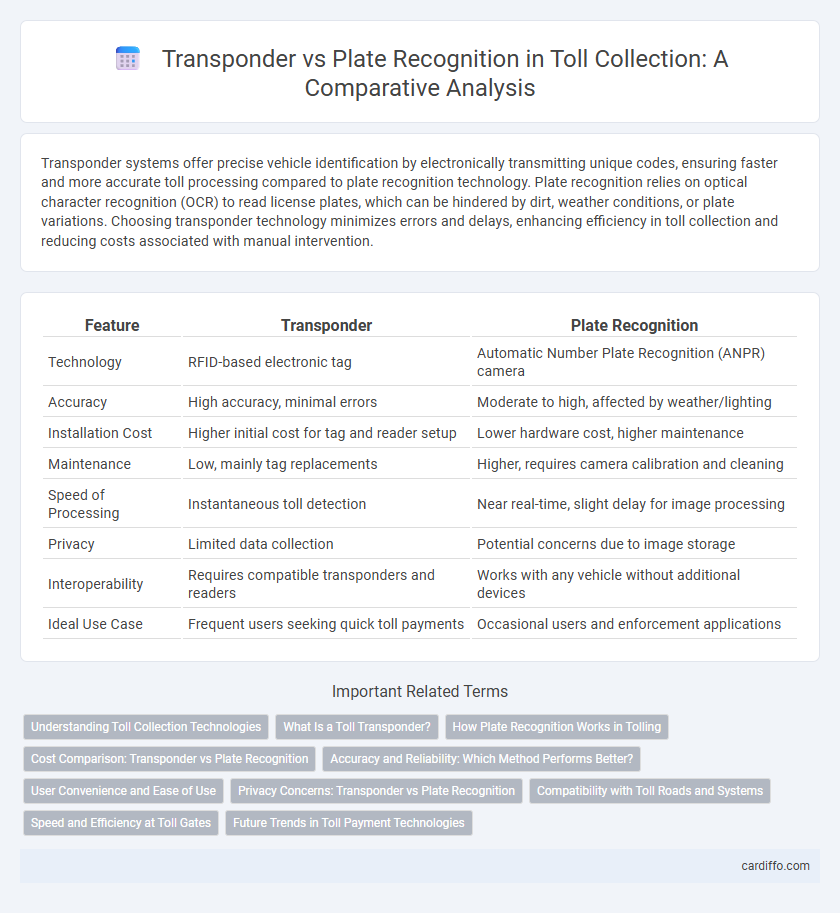Transponder systems offer precise vehicle identification by electronically transmitting unique codes, ensuring faster and more accurate toll processing compared to plate recognition technology. Plate recognition relies on optical character recognition (OCR) to read license plates, which can be hindered by dirt, weather conditions, or plate variations. Choosing transponder technology minimizes errors and delays, enhancing efficiency in toll collection and reducing costs associated with manual intervention.
Table of Comparison
| Feature | Transponder | Plate Recognition |
|---|---|---|
| Technology | RFID-based electronic tag | Automatic Number Plate Recognition (ANPR) camera |
| Accuracy | High accuracy, minimal errors | Moderate to high, affected by weather/lighting |
| Installation Cost | Higher initial cost for tag and reader setup | Lower hardware cost, higher maintenance |
| Maintenance | Low, mainly tag replacements | Higher, requires camera calibration and cleaning |
| Speed of Processing | Instantaneous toll detection | Near real-time, slight delay for image processing |
| Privacy | Limited data collection | Potential concerns due to image storage |
| Interoperability | Requires compatible transponders and readers | Works with any vehicle without additional devices |
| Ideal Use Case | Frequent users seeking quick toll payments | Occasional users and enforcement applications |
Understanding Toll Collection Technologies
Transponder systems use RFID technology to automatically identify vehicles, enabling faster and more accurate toll collection compared to plate recognition. Plate recognition relies on optical character recognition (OCR) to read license plates, which can be affected by weather and plate condition, potentially causing errors or delays. Combining both technologies enhances toll collection efficiency by reducing fraud, improving vehicle identification accuracy, and streamlining payment processing.
What Is a Toll Transponder?
A toll transponder is an electronic device mounted in a vehicle that wirelessly communicates with toll collection systems to enable automatic payment. It uses radio-frequency identification (RFID) technology to instantly deduct toll fees from a prepaid account, eliminating the need to stop at toll booths. Compared to plate recognition systems, transponders provide faster, more accurate toll processing and reduce errors caused by license plate misreads.
How Plate Recognition Works in Tolling
Plate recognition in tolling relies on advanced Automatic Number Plate Recognition (ANPR) technology that captures vehicle license plates using high-resolution cameras at toll points. The system processes the image with optical character recognition (OCR) software to accurately extract the plate number and cross-references it with a database for billing or enforcement. ANPR offers seamless vehicle identification without requiring physical transponders, enabling efficient toll collection and reducing congestion at toll plazas.
Cost Comparison: Transponder vs Plate Recognition
Transponder systems incur upfront costs for device purchase and installation but offer lower transaction fees and faster processing, reducing toll collection expenses over time. Plate recognition relies on camera infrastructure and software, often resulting in higher operational costs due to image processing, license plate database management, and manual enforcement for unpaid tolls. Evaluating total cost of ownership highlights that transponders typically provide more cost-effective solutions for frequent toll users, whereas plate recognition can increase administrative and enforcement expenses.
Accuracy and Reliability: Which Method Performs Better?
Transponder systems offer higher accuracy and reliability in toll collection due to real-time vehicle identification using RFID technology, reducing errors caused by environmental factors. Plate recognition relies on optical character recognition (OCR), which can be affected by poor lighting, dirty plates, or distorted characters, leading to potential misreads and fines disputes. Therefore, transponders consistently outperform license plate recognition systems in ensuring precise and dependable toll transactions.
User Convenience and Ease of Use
Transponder toll systems offer superior user convenience by enabling automatic, hands-free payment without requiring drivers to slow down or stop, enhancing ease of use. Plate recognition technology eliminates the need for physical devices, but may involve delays or manual intervention if license plate information is unclear. Users benefit most from transponder systems due to real-time processing and seamless integration with toll accounts.
Privacy Concerns: Transponder vs Plate Recognition
Transponder systems store encrypted vehicle and driver data, minimizing the risk of unauthorized access but raising concerns about continuous tracking and data retention policies. Plate recognition technology captures and processes license plate images, potentially exposing drivers to broader surveillance and misuse of personal information if stored improperly. Privacy advocates emphasize the need for stringent data protection regulations and transparency to mitigate risks associated with both toll collection methods.
Compatibility with Toll Roads and Systems
Transponder technology offers broad compatibility with many toll roads and electronic toll collection systems worldwide, ensuring seamless travel across multiple regions without stopping. License plate recognition depends on high-quality cameras and can face challenges on toll roads with limited camera infrastructure or varying regulations, reducing its effectiveness. Vehicles equipped with transponders benefit from faster processing and guaranteed recognition, making them the preferred choice for consistent toll road access.
Speed and Efficiency at Toll Gates
Transponder systems enable rapid toll collection by using RFID technology that instantly communicates with toll gates, minimizing vehicle slowdown. Plate recognition relies on high-resolution cameras and OCR software to accurately record license plates but may cause delays due to image processing times and environmental factors. Transponders generally offer higher speed and efficiency at toll gates, reducing congestion and improving traffic flow compared to plate recognition systems.
Future Trends in Toll Payment Technologies
Transponder systems are evolving with increased integration of IoT and real-time data analytics for seamless toll payments, reducing delays and improving traffic flow efficiency. Plate recognition technology leverages advanced AI and machine learning algorithms to enhance accuracy, enabling contactless toll collection without the need for physical devices. Future trends indicate a hybrid approach combining both technologies to optimize user convenience and infrastructure adaptability in smart transportation networks.
Transponder vs Plate recognition Infographic

 cardiffo.com
cardiffo.com